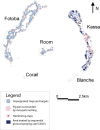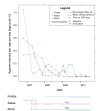Progress towards the eradication of Tsetse from the Loos islands, Guinea
- PMID: 21310074
- PMCID: PMC3048576
- DOI: 10.1186/1756-3305-4-18
Progress towards the eradication of Tsetse from the Loos islands, Guinea
Abstract
Background: The tsetse fly Glossina palpalis gambiensis is the main vector of sleeping sickness (Human African Trypanosomiasis - HAT) in West Africa, in particular in littoral Guinea where this disease is currently very active. The Loos islands constitute a small archipelago some 5 km from mainland Guinea, where G. p. gambiensis is well known as a nuisance and potential disease vector by inhabitants of the three main islands, Fotoba, Room, and Kassa. The National Control Program against HAT of Guinea has decided to eradicate tsetse in Loos islands in order to sustainably protect humans and economic activities. After baseline data collection, tsetse control began on the islands in 2006. On each of the three islands a specific combination of control methods was implemented according to the entomological situation found.
Results: Starting densities before control operations were 10, 3 and 1 tsetse/trap/day in Kassa, Room and Fotoba respectively, but by July 2010, tsetse were no longer caught in any of the sentinel traps used for monitoring. The reduction rate was faster where several control methods were implemented as a combination (impregnated traps and targets ITT, selective groundspraying, epicutaneous insecticide treatment of pigs, and impregnated fences around pig pens), whereas it was slower when ITT were used as the only control method.
Conclusions: This 100% suppression is a promising step in the eradication process, but G. p. gambiensis may still occur at very low, undetectable, densities on the archipelago. Next step will consist in assessing a 0.05 probability of tsetse absence to ascertain a provisional eradication status. Throughout these operations, a key factor has been the involvement of local teams and local communities without whom such results would be impossible to obtain. Work will continue thanks to the partners involved until total eradication of the tsetse on Loos islands can be declared.
Figures



References
-
- Kagbadouno M, Camara M, Bouyer J, Hervouet JP, Courtin F, Jamonneau V, Jamonneau P. Tsetse elimination: its interest and feasibility in the historical sleeping sickness focus of loos islands, Guinea. Parasite. 2009;16:29–35. - PubMed
-
- Camara M, Kaba D, KagbaDouno M, Sanon JR, Ouendeno FF, Solano P. Human African trypanosomiasis in the mangrove forest in Guinea: epidemiological and clinical features in two adjacent outbreak areas. Med Trop. 2005;65:155–161. - PubMed
-
- Jamonneau V, Bucheton B, Kaboré J, Ilboudo H, Camara O, Courtin F, Solano P, Kaba D, Kambire R, Lingue K, Camara M, Baelmans R, Lejon V, Büscher P. Immune trypanolysis is a marker for T. b. gambiense contact: applications for diagnosis and surveillance of sleeping sickness in West Africa. PLoS Negl Trop Dis. 2010. in press . - PMC - PubMed
Publication types
MeSH terms
LinkOut - more resources
Full Text Sources

